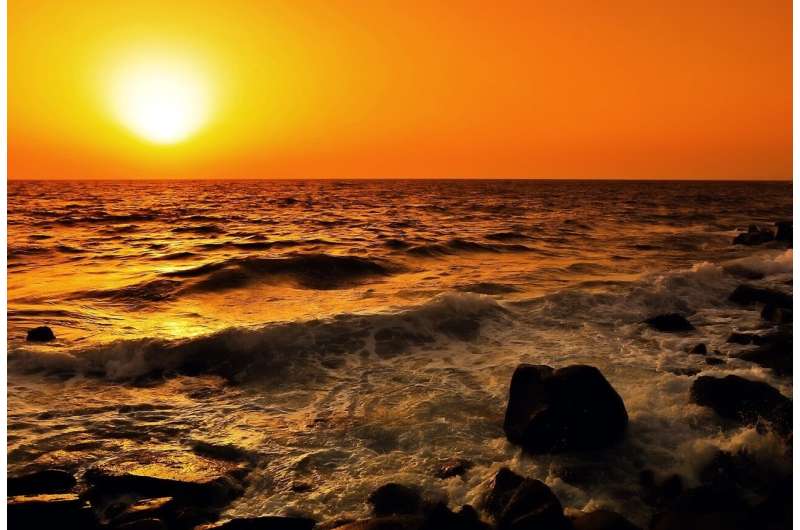This article has been reviewed according to Science X's editorial process and policies. Editors have highlighted the following attributes while ensuring the content's credibility:
fact-checked
peer-reviewed publication
trusted source
proofread
The clock is ticking. Can 'scientific diplomacy' save the world's hottest sea?

Already the world's hottest coastal environment in the summer, the shallow sea between the Arabian peninsula and southwestern Iran continues to heat at a breathtaking pace.
"The Middle East is one of the worst areas in terms of how rapidly temperature change is occurring," says Brian Helmuth, Northeastern professor of marine and environmental science.
In the past, geopolitical tensions among the gulf states precluded regional cooperation to address the effects of climate change and pollution in the water body known as the Persian or Arabian Gulf.
But an improvement in diplomatic relations among gulf nations presents "a window of opportunity" to develop a regional network of scientists to share data and come up with marine conservation strategies that cut across borders, Helmuth says in a Royal Society Open Science article he co-authored that was published Sept. 27.
The clock is ticking
Sea surface temperatures have been recorded as high as 99.5° Fahrenheit in Kuwait Bay. The result is "many of the (gulf's) species live close to their physiological limits," the article says.
A rise in temperature and salinity and a decrease in pH and dissolved oxygen "all make the gulf a laboratory for the most acute effects of future climate change," the report says.
It says the gulf "is also a hotspot for rapid coastal development" and suffers pollution from the oil industry, all of which are damaging to coral reefs, mangroves, mudgrass and seagrass habitats.
The situation has gotten so perilous that the only source of freshwater into the gulf, the Shatt Al-Arab River at the confluence of the Tigris and Euphrates, has reversed its flow, says Nadia Al-Mudaffar Fawzi, a retired professor from the University of Basra, one of the report's co-authors.
The river's increased salinity threatens freshwater supplies in Basra, Iraq, says Al-Mudaffar Fawzi, whom Helmuth says has a courtesy appointment at Northeastern as a visiting professor due to their collaborations.
"Most of the issues come from political issues between the countries," says Al-Mudaffar Fawzi, who adds that the decreased river flow stems from the water's diversion upstream for electricity and agriculture.
"That's where we came up with the idea of scientists working together," she says.
"Scientists can act really fast, we can be nimble," Helmuth says. "We can respond quickly because we've already established relationships" with organizations such as the Gulf Cooperation Council.
Marine animal sanctuaries and stranding networks
The article in the Royal Society Open Science journal lays out an agenda that includes developing a regional network of scientists who can share data, work together on regional habitat mapping and identify gaps in knowledge that need to be addressed.
It also recommends establishing the gulf's first marine mammal stranding network as well as marine animal sanctuaries, called peace parks.
Marine animals including large mammals like whales and dugongs, a relative of the manatee, "ignore geopolitical boundaries" in their movements, Helmuth says.
The paper recommends establishing the gulf's first "transboundary marine park" in an area shared by Bahrain, Qatar and Saudi Arabia that is home to thriving dugong populations.
"The park might involve collaboration on pollution control. It can simply involve just protection from development," Helmuth says.
Smithsonian gets involved
The Smithsonian Institution convened the first meeting in January 2022 of the authors of the report, who have been meeting periodically ever since, says Helmuth, who has worked with Al-Mudaffar Fawzi and other scientists from Iraq for the past dozen years or so.
Al-Mudaffar Fawzi says the authors also include researchers from Iran and the Arab Gulf states. Individuals who are working in but not from Oman and Saudi Arabia also contributed to the report.
"This group worked wonderfully together. It was a really good experience. Hopefully it will continue with more people. My personal aim is to involve more women of Arab origin in the group," she says.
"The fence-mending that has happened throughout the gulf means that it's an opportune time for existing cooperations between scientists to be used as a template for stronger relationships between countries," says Nicholas Pyenson, curator of fossil marine mammals at the Smithsonian and a co-author of the report.
"A healthier gulf means healthier people who rely on its ecosystems," he says.
Signs of hope
Geography aggravates some of the stresses faced by the gulf. It has only one outlet, to the Indian Ocean, Pyenson says.
"But there are some hopeful spots," Helmuth says. "Our colleagues in Iraq discovered corals that are managing to survive. Understanding how we can identify resilient corals is a major restoration goal around the world."
Many of the paper's authors plan to meet in November in Doha, Qatar, to discuss the next steps, he says.
The goal is to have scientists in the gulf states work with their governments to share research and develop regional partnerships.
"Solutions can't happen in a vacuum," Helmuth says. "They really need to be coordinated."
More information: Clare M. Fieseler et al, Expanding ocean protection and peace: a window for science diplomacy in the Gulf, Royal Society Open Science (2023). DOI: 10.1098/rsos.230392
Journal information: Royal Society Open Science
Provided by Northeastern University





















